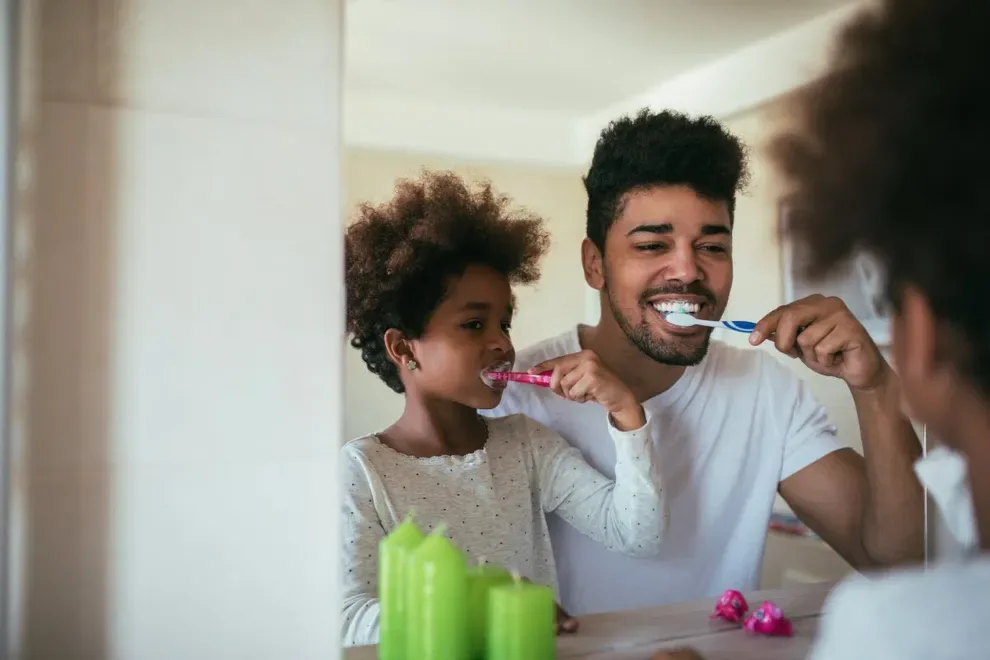My Child Ate Toothpaste - Now What?

Table of Contents
- What Happens if a Child Swallows Toothpaste?
- What Should I Do?
- Prevention
- Tips for Safe Toothbrushing Training
- References
Whether on purpose or by accident, children sometimes end up swallowing toothpaste at some point. On the surface, such an event would not seem to be a big deal. But it can be.
Most toothpastes contain fluoride, an ingredient that can be toxic in large amounts. Ingesting too much may cause vomiting, nausea, and other unpleasant symptoms.
If your child swallows toothpaste, parents should try to figure out how much was consumed. Most of the time, they don’t need to make a trip to the emergency room for immediate treatment. You can take specific steps to help your child avoid fluoride toxicity, including teaching them how to brush their teeth safely without swallowing any toothpaste or foam.
What Happens If a Child Swallows Toothpaste?
Toothpaste is not intended for human consumption. While it is safe to use in recommended amounts, it contains fluoride, a toxic chemical that can make you sick in large doses.
Fortunately, fluoride is only minimally toxic, so it rarely causes serious problems. Scientists estimate that a child must ingest 5 mg of fluoride per kilogram of body weight for the substance to have any toxic effects. At elevated levels, fluoride can cause:
Nausea
Vomiting
Abdominal pain
Diarrhea
Periostitis (inflammation of the tissue around your bones)
It would take a dose of more than 16 mg per kilogram of body weight for fluoride poisoning to become lethal. Given that there is only 1.3 mg of fluoride in a typical squeeze of toothpaste, most children do not ingest anywhere near enough toothpaste for this to be a concern.
However, children who ingest moderate amounts of fluoride frequently over time can develop a condition called dental fluorosis. Although the condition is not dangerous, it does cause permanent pits and cloudy white patches to appear on a child's teeth. Ingesting larger amounts of fluoride regularly can lead to skeletal fluorosis, a painful condition that stiffens a person’s joints and ligaments.
What Should I Do If My Child Swallows Toothpaste?
If you know your child consumed only a small amount of toothpaste, there is no need to worry about their health. They may develop a minor stomachache at most. Remind your child that they are not supposed to eat toothpaste and try not to worry too much - unless this type of consumption becomes a habit, there is no harm done.
If you’re not sure how much toothpaste was ingested, call poison control. The staff will help you determine whether your child has swallowed enough toothpaste to require medical intervention. If so, they will advise you on the next steps to ensure your child gets the help they need.
If you have determined that your child does not need emergency treatment, you can give them a calcium-rich snack such as milk, cheese, or yogurt. The calcium in these snacks will bind with the fluoride in your child’s system and make them less likely to develop an upset stomach or other unpleasant symptoms.
Prevention
Fluoride toxicity is almost always preventable. Here are some tips to help you keep your child safe from fluoride's negative effects:
Teach your child why it’s important not to swallow toothpaste. It may be helpful to tell them that toothpaste is like medicine: It’s OK to use it for specific purposes, but eating or playing with it can make you sick.
Supervise your child while they brush their teeth until they are old enough to be trusted not to swallow the toothpaste.
Use only a smear of fluoride toothpaste (about the size of a grain of rice) to brush your child’s teeth until they turn 3. After that point, switch to a pea-sized amount until they turn 6.
Store toothpaste out of sight and in a location that your child can’t easily reach.
Tips for Safe Toothbrushing Training
Teaching your child to brush their teeth safely can help to minimize their fluoride exposure.
Use a fluoride-free training toothpaste at first. You can find this type of toothpaste at any drug store or grocery store. It comes in child-friendly flavors like bubblegum and fruit punch and often includes characters from popular children’s media on the packaging.
Remind your child to spit out the toothpaste foam when they are done with brushing. They may still swallow a bit at first, but try to instill the habit in them before they begin using fluoride toothpaste on their own.
Consider giving your child an electric or battery-powered toothbrush. The spinning motion will help spread the toothpaste around their mouth and make it harder for them to swallow much of it.
Brush your teeth alongside your child. Show them what good brushing looks like and make sure they see you spit out your toothpaste foam. This also allows you to supervise their brushing until you feel confident that they know not to swallow the paste.
